Serving 695 students in grades Prekindergarten-6, Txuj Ci Hmong Language & Culture Lo ranks in the bottom 50% of all schools in Minnesota for overall test scores (math proficiency is bottom 50%, and reading proficiency is bottom 50%).
The percentage of students achieving proficiency in math is 31% (which is lower than the Minnesota state average of 45%). The percentage of students achieving proficiency in reading/language arts is 26% (which is lower than the Minnesota state average of 51%).
The student:teacher ratio of 12:1 is lower than the Minnesota state level of 13:1.
Minority enrollment is 99% of the student body (majority Asian), which is higher than the Minnesota state average of 39% (majority Black and Hispanic).
Quick Stats (2025)
- School Type: Magnet School
- Grades: Prekindergarten-6
- Enrollment: 695 students
- Student:Teacher Ratio: 12:1
- Minority Enrollment: 99%
- Overall Testing Rank: Bottom 50% in MN
- Math Proficiency: 31% (Btm 50%)
- Reading Proficiency: 26% (Btm 50%)
- Science Proficiency: 20-24% (Btm 50%)
- Source: National Center for Education Statistics (NCES), MN Dept. of Education
Top Rankings
Txuj Ci Hmong Language & Culture Lo ranks among the top 20% of public schools in Minnesota for:
Category
Attribute
Percent Eligible For Free Lunch
School Overview
Txuj Ci Hmong Language & Culture Lo's student population of 695 students has grown by 6% over five school years.
The teacher population of 57 teachers has grown by 26% over five school years.
School Type
Grades Offered
Grades Prekindergarten-6
Total Students
695 students
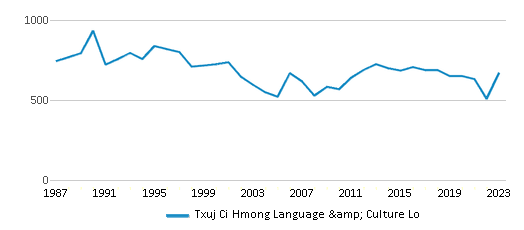
Gender %
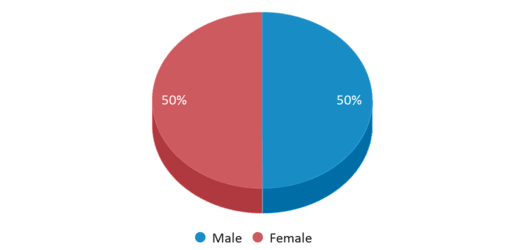
Total Classroom Teachers
57 teachers
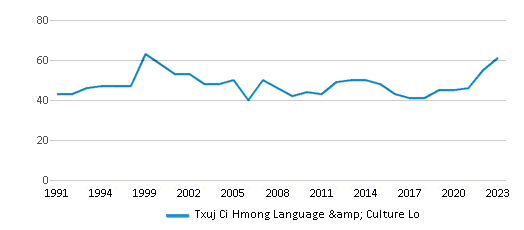
Students by Grade
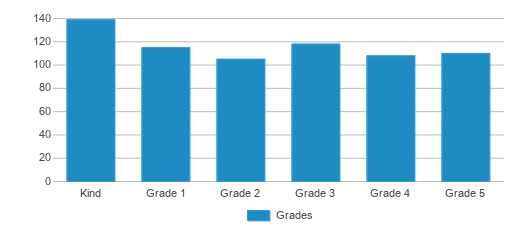
School Rankings
Txuj Ci Hmong Language & Culture Lo ranks within the bottom 50% of all 1,860 schools in Minnesota (based off of combined math and reading proficiency testing data).
The diversity score of Txuj Ci Hmong Language & Culture Lo is 0.15, which is less than the diversity score at state average of 0.59. The school's diversity has stayed relatively flat over five school years.
Overall Testing Rank
#1511 out of 1860 schools
(Bottom 50%)
(Bottom 50%)
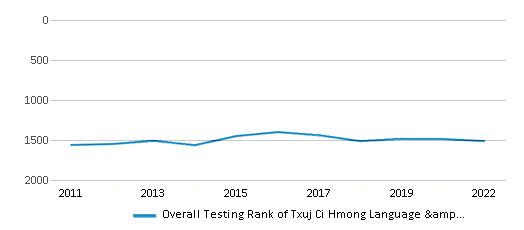
Math Test Scores (% Proficient)
31%
45%
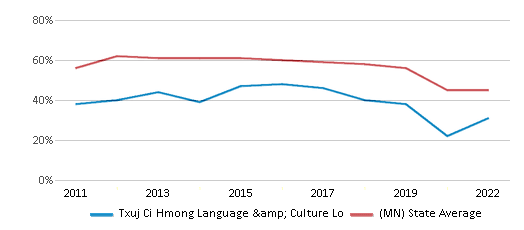
Reading/Language Arts Test Scores (% Proficient)
26%
51%
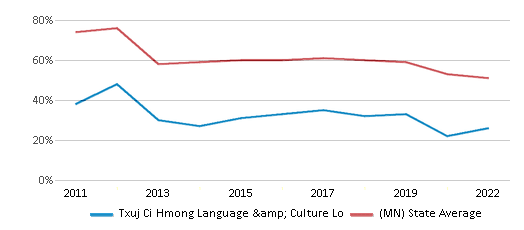
Science Test Scores (% Proficient)
20-24%
41%
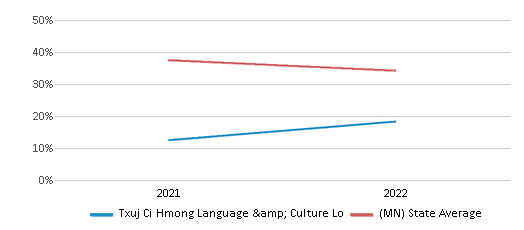
Student : Teacher Ratio
12:1
13:1
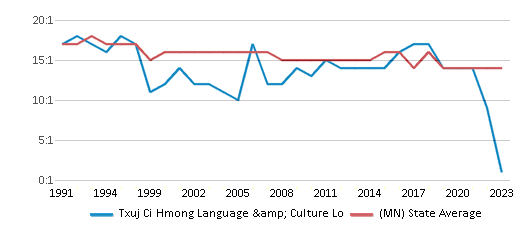
American Indian
n/a
2%
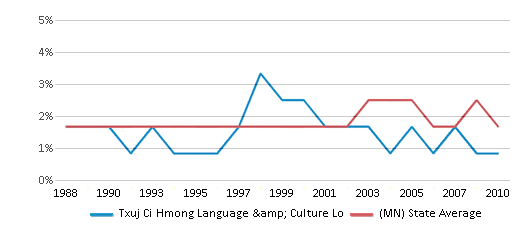
Asian
92%
7%
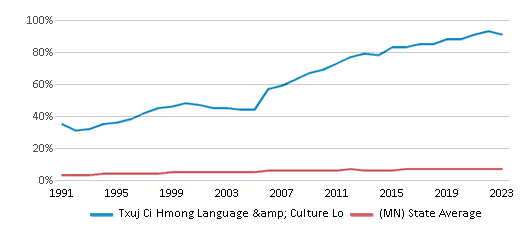
Hispanic
3%
12%
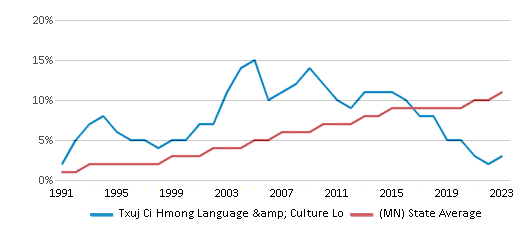
Black
1%
12%
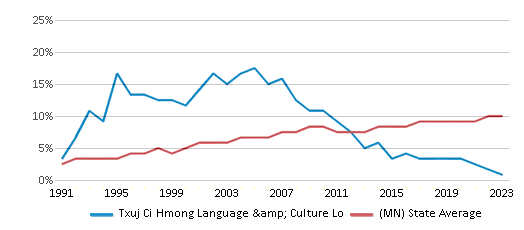
White
1%
61%
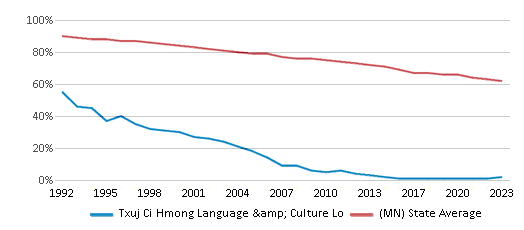
Hawaiian
n/a
n/a
Two or more races
3%
6%
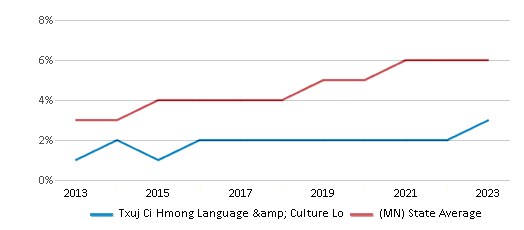
All Ethnic Groups
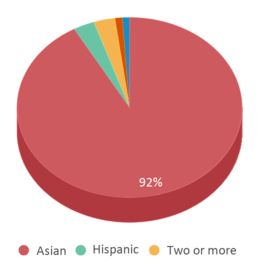
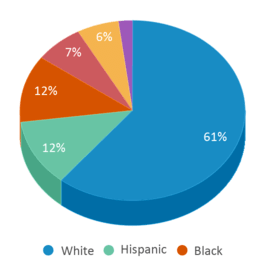
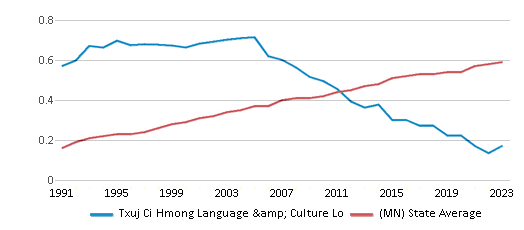
Eligible for Free Lunch
67%
36%
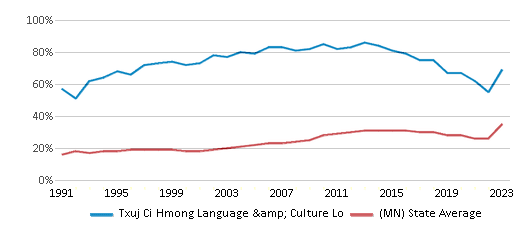
Eligible for Reduced Lunch
17%
7%
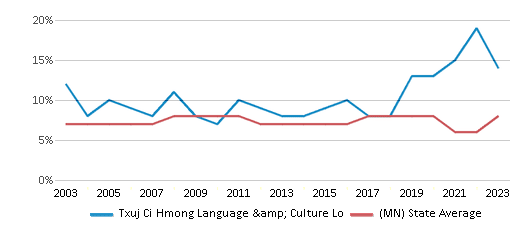
School Statewide Testing
School District Name
Source: National Center for Education Statistics (NCES), MN Dept. of Education
Profile last updated: 02/09/2025
Frequently Asked Questions
What is Txuj Ci Hmong Language & Culture Lo's ranking?
Txuj Ci Hmong Language & Culture Lo is ranked #1511 out of 1,860 schools, which ranks it among the bottom 50% of public schools in Minnesota.
What schools are Txuj Ci Hmong Language & Culture Lo often compared to?
Txuj Ci Hmong Language & Culture Lois often viewed alongside schools like Hmong College Prep Academy Middle School, Hmong College Prep Academy High School by visitors of our site.
What percent of students have achieved state testing proficiency in math and reading?
31% of students have achieved math proficiency (compared to the 45% MN state average), while 26% of students have achieved reading proficiency (compared to the 51% MN state average).
How many students attend Txuj Ci Hmong Language & Culture Lo?
695 students attend Txuj Ci Hmong Language & Culture Lo.
What is the racial composition of the student body?
92% of Txuj Ci Hmong Language & Culture Lo students are Asian, 3% of students are Hispanic, 3% of students are Two or more races, 1% of students are Black, and 1% of students are White.
What is the student:teacher ratio of Txuj Ci Hmong Language & Culture Lo?
Txuj Ci Hmong Language & Culture Lo has a student ration of 12:1, which is lower than the Minnesota state average of 13:1.
What grades does Txuj Ci Hmong Language & Culture Lo offer ?
Txuj Ci Hmong Language & Culture Lo offers enrollment in grades Prekindergarten-6
What school district is Txuj Ci Hmong Language & Culture Lo part of?
Txuj Ci Hmong Language & Culture Lo is part of Saint Paul School District.
In what neighborhood is Txuj Ci Hmong Language & Culture Lo located?
Txuj Ci Hmong Language & Culture Lo is located in the Payne Phalen neighborhood of Saint Paul, MN. There are 16 other public schools located in Payne Phalen.
School Reviews
5 3/15/2010
I have 3 boys at Phalen Lake Hmong Studies. I wanted a school that would teach my children the value of effort and hard work and to respect others. As well as learn how to live in a truly global society. Phalen Lake has done all of this. They have a Hmong culture program that lets the kids learn in depth about the Hmong culture always with an eye to using this learning to explore and learn about other cultures as well. This cultural education is supported by a staff that not only encourages students to work hard and do their best, but has the welfare of the students at heart. It is a fabulous environment for anyone.
Review Txuj Ci Hmong Language & Culture Lo. Reviews should be a few sentences in length. Please include any comments on:
- Quality of academic programs, teachers, and facilities
- Availability of music, art, sports and other extracurricular activities
Recent Articles

What Is A Charter School?
Explore the world of charter schools in this comprehensive guide. Learn about their history, how they operate, and the pros and cons of this educational innovation. Discover key facts about charter schools, including admission policies, demographics, and funding, as well as what to look for when considering a charter school for your child.

10 Reasons Why High School Sports Benefit Students
Discover the 10 compelling reasons why high school sports are beneficial for students. This comprehensive article explores how athletics enhance academic performance, foster personal growth, and develop crucial life skills. From improved fitness and time management to leadership development and community representation, learn why participating in high school sports can be a game-changer for students' overall success and well-being.

February 05, 2025
Understanding the U.S. Department of Education: Structure, Impact, and EvolutionWe explore how the Department of Education shapes American education, from its cabinet-level leadership to its impact on millions of students, written for general audiences seeking clarity on this vital institution.







